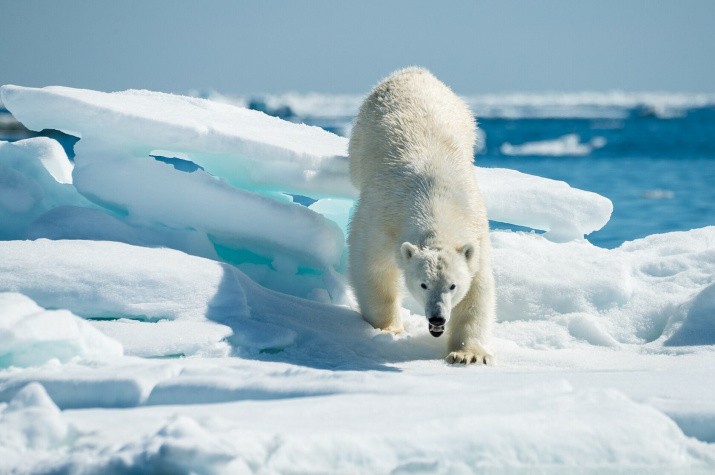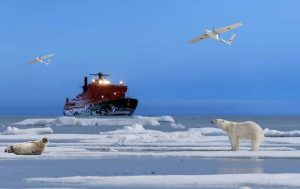
The teleconference connected two conference venues — the Chukchi Arctic Scientific Center in Anadyr and the Headquarters of the Russian Geographical Society in Moscow. Scientists, experts, representatives of government and business told about scientific achievements, discussed measures to preserve the ecology and biological diversity of the Arctic. The hero of the day was a polar bear — the largest and strongest predator on the planet and one of the most striking indicators of the Arctic’s well-being.
According to the International Union for Conservation of Nature, the world population of these animals has about 26 thousand individuals.
The conference participants summed up the results of the “White Bear Census”, which took place last year on Wrangel Island. Bears were counted literally on their heads, for the first time in the world using drones for this.
The president of the ecological center “Ecofactor” Vladimir Chernook told about how it happened. Russian Orlan drones took more than 22 thousand pictures from a height of 200-300 m. Each device, equipped with a very high-resolution camera, thermal imager, geolocation and other devices, was in the air without landing for 10 hours, surveying an area of 1000 km.
Chernook noted the advantages of the new research method. It is much cheaper than flying by planes or helicopters; it does not pose a danger to humans — if the drone crashes, no one will be hurt; it is eco—friendly, does not frighten animals – at a distance of 400 m, the sound from the device is no longer audible; it allows you to explore large areas in a relatively short time.
Scientists made 512 photo portraits of polar bears, noting the time and coordinates of the meeting place with him. All images were processed manually. When the number of bears visually recorded during the drone’s flight was extrapolated to the entire area of the island, it turned out that there were 864 of them.
Ten organizations participated in the project. Deputy Executive Director of the RGS Sergey Korlykhanov noted in his report:
— The White Bear Census is another example of cooperation between the Russian Geographical Society and business companies for the conservation of biodiversity. Air monitoring of polar bears using long–range unmanned aerial vehicles has become one of the key events of the joint integrated expedition of the RGS and the Main Command of the Navy “Umka-2022” with the participation of the Roszapovedcenter and the company “Ecofactor”.
In continuation, Sergey Korlykhanov noted that the RGS not only provides scientists with the opportunity to conduct research during their expeditions, gives access to special vehicles and the opportunity to get to hard-to-reach locations. In the logic of “civil science”, the Society attracts volunteers to participate in scientific expeditions. Volunteers help scientists in research by doing work that does not require academic training or higher education, in particular, data collection and processing for researchers.
The conference participants also spoke about the deterioration of the ecological and physical conditions of the survival of polar bears. According to Alexey Yakovlev, head of the Department of Natural Resources and Ecology of the Chukotka Autonomous Okrug, due to climate change, Arctic pollution and uncontrolled fishing, the population of polar bears may decrease by 30% by 2050.
The biggest danger for them is climate change, which leads to a reduction in ice, including drifting. Alexey Yakovlev noted that as a result of climate change, the ice in the Chukchi sector of the Arctic is retreating to the north, beyond 82 ° north latitude, that is, more than 1000 km north of the water area where polar bears usually hunt.
Animals are forced either to land on land, which leads to an increase in the number of meetings and conflicts with humans, or to go to the pole for ice, for which they have to travel long distances, which leads to their exhaustion, and sometimes death. In polar bears, the time regime of the reproductive cycle is disrupted, the timing of the females’ occurrence in the ancestral dens, which they are sometimes forced to arrange on drifting ice, is shifted.
Pollution of the marine area and the Arctic coast by fuel combustion products, heavy metals, fuels and lubricants, oil, plastic and other waste products of human activity is no less destructive for these powerful predators. Toxic substances, accumulating in the body of bears, lead to diseases and a reduction in the life expectancy of animals.
“Anthropogenic activity in the Arctic affects the ecosystem, and one of the conditions for the functioning of any company in this region is the preservation of biological diversity and non—harm to it,” Sergey Korlykhanov stressed.
Since 2010, the RGS, together with the Ministry of Defense of the Russian Federation, has been cleaning the shores of the Arctic Ocean from unused fuels and lubricants, machinery, equipment and garbage left in the 90s as part of the Arctic project. General cleaning”.
Conducting economic activities in the Arctic, it is necessary to take into account the migration routes of polar bears and the location of the rookeries of walruses and seals when adjusting the routes of ships along the Northern Sea Route, as well as to conduct regular comprehensive monitoring of the environment in the Arctic.
The “White Bear Census” is not finished. According to Olga Krever, deputy director of the Roszapovedcenter of the Ministry of Natural Resources of Russia, Wrangel Island is a Klondike of polar bears, not only a maternity hospital, but also a key habitat for them. In total, the Chukchi-Alaskan population has about 3 thousand polar bears. In the future, scientists plan to expand the survey area to the entire Wrangel Island, count the number of bears on Herald Island and in the 12-mile zone of the sea area — images taken from drones showed that there are also quite a lot of polar bears in the sea on the ice. Then the specialists will explore the Bear Islands archipelago in the East Siberian Sea and will gradually move further west, examining step by step the entire Arctic zone of Russia.
Marina Kruglyakova


